General's Son Crashes SUV into Wat Phnom Posts
Three of the concrete posts surrounding Wat Phnom were damaged when a luxury Lexus SUV carrying the son of RCAF (CC: Cambodian Army) General Kao Try spun out of control and smashed into a protective barrier and a tree at the city's historic pagoda, police said Tuesday
Police said the vehicle was traveling at high speed when it turned right off Norodom Boulevard and crashed into Wat Phnom Saturday evening, said Mao Sony, deputy municipal traffic police chief.
Mao Sony said Kao Try's son was not injured but police reported that he acted aggessively when they arrived at the scene.
"I heard on the [police] radio that he was using derogatory words against police and a journalist,' Mao Sony said.
Pich Socheata, deputy govenor of Daun Penh district, said Kao Try has promised to pay for repairs. Pich Socheata said she was not impressed with the behaviour of the general's son, who she alleged grabbed a journalist by the hair after the crash. She also said that she was offended by the 'harsh words' used by both Kao Try, who arrived at the scene, and his son.
'I walked away because I could not bear the words,' she added.
Kao Try denied that his son was driving the car or that the Lexus had been racing. He also denied that his son manhandled a journalist or that strong words were directed at Pich Socheata and the police.
"My son did not grab anyone by the hair,' Kao Try said, adding that poor lighting around Wat Phnom contributed to the crash.
On Monday night another vehicle crashed at the same spot at Wat Phnom, though no one was hurt, Mao Sony said.
Should I comment? Ok then:
- Crash 1 happens Saturday evening, makes the Daily on Wednesday, crash 2 happens on Monday night , makes the daily on Wednesday. Why did the police inform the media only on Tuesday? Cover up? Possibly the culprits must have overstepped a (unseen) line otherwise it would probably never been heard of.
- The intersection Norodom with the roundabout around the Wat is spacious. Norodom is spacious, so not so hard to think of speeding as a possible cause. Poor lighting? That's a fact of life in Phnom Penh.
- Everybody seems to have heard 'harsh words', why deny this? Maybe Mel Gibson can be regarded as a model.
- Who was driving the car?
- When will the driver be charged? Sorry, it has probably been dealt with. The general has promised to pay for the repairs to the Wat. How abou a fine?





